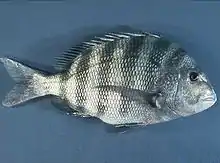| Microcotyle archosargi | |
|---|---|
 | |
| Microcotyle archosargi, original description [1] | |
| Scientific classification | |
| Domain: | Eukaryota |
| Kingdom: | Animalia |
| Phylum: | Platyhelminthes |
| Class: | Monogenea |
| Order: | Mazocraeidea |
| Family: | Microcotylidae |
| Genus: | Microcotyle |
| Species: | M. archosargi |
| Binomial name | |
| Microcotyle archosargi MacCallum, 1913 [1] | |
| Synonyms | |
|
Microcotyle Scintillovulva archosargi Unnithan, 1971 [2] Paramicrocotyle archosargi (MacCallum, 1913) Caballero & Bravo-Hollis, 1965 [3] | |
Microcotyle archosargi is a species of monogenean, parasitic on the gills of a marine fish. It belongs to the family Microcotylidae.[1] It was first described by MacCallum in 1913 based on ten specimens.[1] Hargis (1956) pointed out that the description and figures given by MacCallum were poor in details.[4]
Systematics
In 1971, Unnithan created the combination Microcotyle Scintillovulva archosargi,[2] but Unnithan's assignment of ‘‘(MacCallum, 1913) comb. n.’’ as authorship of M. (S.) archosargi was considered incorrect according to the International Code of Zoological Nomenclature by Kritsky & Bakenhaster.[5] Microcotyle archosargi was transferred by Caballero & Bravo-Hollis to the genus Paramicrocotyle as Paramicrocotyle archosargi n. comb.[6] Mamaev, in his revision of the family Microcotylidae, suppressed this combination, reassigned the species to the genus Microcotyle and considered Paramicrocotyle a junior subjective synonym of Microcotyle.[7][8]
Morphology
Microcotyle archosargi has the general morphology of all species of Microcotyle, with a flat body, comprising an anterior part which contains most organs and a posterior part called the haptor. The haptor is symmetrical and bears a number of clamps, arranged as two rows, one on each side. The clamps of the haptor attach the animal to the gill of the fish. There are also two small buccal suckers at the anterior extremity. The digestive organs include an anterior, terminal mouth, a muscular pharynx, and a posterior intestine with two lateral blind-ending branches. Each adult contains male and female reproductive organs. The reproductive organs include an anterior genital atrium, with spines, a dorsal vagina, a single ovary, and a number of testes which are posterior to the ovary.[9]
In 2011, Kritsky and Bakenhaster provided supplementary observations for M. archosargi based on examination of museum specimens and other specimens collected on Archosargus probatocephalus from Florida.[5] The species was also redescribed by Mendoza-Franco et al. in 2018, from Archosargus rhomboidalis,[8] including a drawing of the genital atrium. These authors also provided the first molecular data (28S ribosomal RNA) for Microcotyle archosargi.[8]
Etymology
The specific epithet Microcotyle archosargi is derived from the generic name of the host species Archosargus probatocephalus.[1]
Hosts and localities


The sheepshead Archosargus probatocephalus (Sparidae) is the type-host of Microcotyle archosargi.[1] The species was first described from fish obtained by MacCallum from the New York fish market, as well as the New York Aquarium and the US Fish Commission at Woods Hole, Massachusetts.[1] Despite the indirect source of the specimens, his host record is probably correct.[4] M. archosargi has also been recorded in the type-host from Florida[4][5] and Mexico,[10] and in another sparid host, the western Atlantic seabream Archosargus rhomboidalis.[8]
References
- 1 2 3 4 5 6 7 MacCallum, G.A. (1913) Further notes on the genus Microcotyle. Zoologische Jahrbücher. Abteilung für Systematik, Geographie und Biologie der Tiere, 35, 389-402. PDF in BHL

- 1 2 Unnithan, R. Viswanathan (1971). "On the functional morphology of a new fauna of Monogenoidea on Fishes from Trivandrum and environs. Part IV. Microcotylidae sensu stricto and its repartition into subsidiary taxa". American Midland Naturalist. 85 (2): 366–398. doi:10.2307/2423763. ISSN 0003-0031. JSTOR 2423763.
- ↑ Caballero, E., & Bravo-Hollis, M. (1965). Monogenea (van Beneden, 1858) Carus, 1863 de peces marinos del litoral mexicano del Golfo de México y del Mar Caribe. II. Revista de Biología Tropical, 13(1), 101-121.http://132.248.13.1/pdf/directorio/s/salgado/pdf_10_sep_07/bravo_hollis_salgado_83.pdf

- 1 2 3 Hargis, William J. (1956). "Monogenetic Trematodes of Gulf of Mexico Fishes. Part X. The Family Microcotylidae Taschenberg, 1879". Transactions of the American Microscopical Society. 75 (4): 436–453. doi:10.2307/3223616. ISSN 0003-0023. JSTOR 3223616.
- 1 2 3 Kritsky, Delane C.; Bakenhaster, Micah D. (2010). "Monogenoidean parasites of the gill lamellae of the sheepshead Archosargus probatocephalus (Walbaum) (Perciformes: Sparidae) from the Indian River Lagoon, Florida, with descriptions of four new species of Euryhaliotrema Kritsky & Boeger, 2002 (Dactylogyridae)". Systematic Parasitology. 78 (1): 57–68. doi:10.1007/s11230-010-9282-7. ISSN 0165-5752. PMID 21161491. S2CID 21802558.
- ↑ Caballero y Caballero, E., & Bravo-Hollis, M. (1972). Monogenea (van Beneden, 1858) Carus, 1863 de peces marinos del litoral Mexicano del Golfo de Mexico y del Mar Caribe.V. Revista de Biología Tropical, 20, 151-165. PDF

- ↑ Mamaev, Y. L. (1986). The taxonomical composition of the family Microcotylidae Taschenberg, 1879 (Monogenea). Folia Parasitol, 33, 199-206.https://folia.paru.cas.cz/pdfs/fol/1986/03/02.pdf

- 1 2 3 4 Mendoza-Franco, Edgar F.; Rosado Tun, Mariela del Carmen; Duarte Anchevida, Allan de Jesús; del Rio Rodríguez, Rodolfo E. (2018). "Morphological and molecular (28S rRNA) data of monogeneans (Platyhelminthes) infecting the gill lamellae of marine fishes in the Campeche Bank, southwest Gulf of Mexico". ZooKeys (783): 125–161. doi:10.3897/zookeys.783.26218. ISSN 1313-2970. PMC 6160863. PMID 30275730.

- ↑ Mamaev, Yu.L. (1989) [On species composition and morphological features of the Microcotyle genus (Microcotylidae, Monogenoidea)]. In: Lebedev, B.I. (Ed.) [Investigation in parasitology, collection of papers]. Vladivostok: DVNTs SSSR, 167 pp. [In Russian]
- ↑ Iruegas-Buentello, F. J. (1999). Helmintos parasitos de peces comerciales de la Laguna Madre, San Fernando, Tamaulipas, Mexico. Thesis, Universidad Autonoma de Nuevo Leon, Monterrey, Nuevo Leon, Mexico, 217 pp